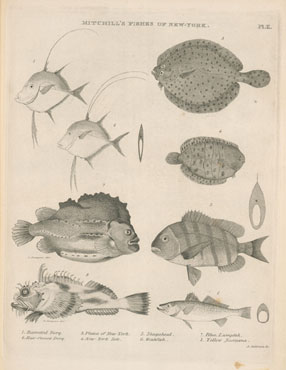

• Intro / Home
• Historical Neighbors
• Street and Backyard
Neighbors
• Park and Green Places
Neighbors
• Shore and Wetlands
Neighbors
• Salt and Freshwater
Neighbors
• Tiny Neighbors
• Unwelcome Neighbors
• Occasional and
Unexpected Neighbors
•
Wildlife Sighting Log
• Resources
• Hours and Tours
• Press Release
• NYPL HOME
| Historical Neighbors | |
Many of the numerous fish species
in New York City waters in the early 19th century were described
by Dr. Samuel Mitchill, and illustrated by "Dr. Samuel Akerly
drawn from nature." Some, such as the Fourspine Stickleback
and Windowpane Flounder, were recorded for the first time. Some fishes common in 1815, such
as the Windowpane, remain abundant in city waters. Others are no
longer found, such as the Sheepshead, named for its facial profile,
which gave its name to the Brooklyn fishing village of Sheepshead
Bay, where it once was common. Animal names are often colorfully descriptive. The Windowpane is nearly transparent. The Lookdown appears to be looking down its nose. The individuals depicted are juveniles, who sport long filaments that help camouflage them in salt marsh grasses. The Sea Ravenís early name "Scorpaena flava" ("Yellow Scorpion") describes a formidable-appearing creature. |
